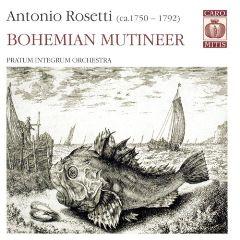Rosetti - Bohemian mutineer (2005)
Antonio Rosetti - Bohemian mutineer (2005)

Symphony in D major (Murray A21). 01. - Largo. Allegro assai [0:07:38.68] 02. - Andante scherzante [0:06:21.70] 03. - Menuetto fresco [0:03:42.77] 04. - Allegro moderato [0:05:31.06] Concerto for horn and orchestra in D minor (Murray C38). 05. - Allegro molto [0:09:38.45] 06. - Adagio [0:05:27.30] 07. - Rondo. Allegro [0:05:19.18] Concerto for violin and Orchestra in D minor (Murray C9). 08. - Allegro maestoso [0:09:04.66] 09. –Adagio [0:06:25.78] 10. -Rondo. Moderato [0:06:04.60] Symphony in G minor (Murray A42 11. - Vivace [0:06:44.82] 12. - Menuetto fresco [0:02:30.90] 13. - Andante ma Allegretto [0:03:41.00] 14. - Capriccio. Allegretto scherzante [0:02:47.02] Helen MacDougall – horn (5-7) Dmitry Sinkovsky – violin (8-10) Pratum Integrum Orchestra Anatolyi Vasiliev - Artistic Director
Caro Mitis has chosen an intriguing and amusing title for a disc of Antonio Rosetti as performed by Russian period instrument group Pratum Integrum Orchestra: Bohemian Mutineer. Its front cover is emblazoned with an old etching of a gigantic fish that would certainly stir up mutiny if it swam up to a vessel filled with nervous sailors. While all of this is very attention grabbing, as Bohemia was a completely landlocked region, one wonders how a Bohemian sailor would gain such experience as to cause a mutiny, but perhaps the point is to paint Rosetti as a radical, a composer whose music blazed new trails in the last part of the eighteenth century that he belonged. It is true that he was an outstanding composer of instrumental music who was viewed in his time as the equal of Mozart and Haydn, and this truth is further amplified in that Rosetti had a provincial musical education and worked in minor courts, having only glancing contact major music centers like Paris and Berlin; he never set foot in Vienna. Unlike Franz Ignaz Beck, who was a "mutineer" in both his work and life, or Karl Ditters von Dittersdorf, who brilliantly maintained the classical-era status quo, Rosetti aimed for the middle, placing him in a class of composers whose aims were very much in sympathy with what Mozart was trying to achieve; grace, eloquence, wit, and that extra, indefinable something that captures one's ear and imagination.
There are no first recordings here, and apart from the Violin Concerto the selection represents some of the better known Rosetti literature. The Symphony in G minor Murray A42 is one of Rosetti's most often performed symphonies and his only one in a minor key. This symphony's uncommon instrumental variety claims one's attention over its storminess and it is well performed here as is the Symphony in D major Murray A21, which bears some superficial similarity to the sound of Mozart's "Prague" and "Linz" symphonies; it has a particularly affecting Andante scherzante. Rosetti's horn concertos have been famous even when Rosetti himself was not so and whether or not Mozart modeled his horn concertos after Rosetti's they stand perfectly well on their own; they are exciting, rhythmically vibrant, and put a considerable challenge to the horn. Pratum Integrum's period horn players are more than up to the task, and horn fanciers will get a real kick out of their energetic and alert performance. The Violin Concerto in D minor Murray C9 is the weakest among these efforts; the violin solo part is flashy without being particularly substantive, and it appears this was written for a violinist who was somewhat less of a virtuoso than Anton Janitsch, first violinist of the Oettingen-Wallerstein court orchestra where Rosetti was employed.
While Caro Mitis' Bohemian Mutineer might not make you want to set the captain out in a lifeboat at cutlass-point, it is a highly enjoyable listen, very well recorded, and may well serve as a solid basis from which one might make a more exploratory voyage through the many works of Rosetti. ---Uncle Dave Lewis, AllMusic Review
download (mp3 @320 kbs):








